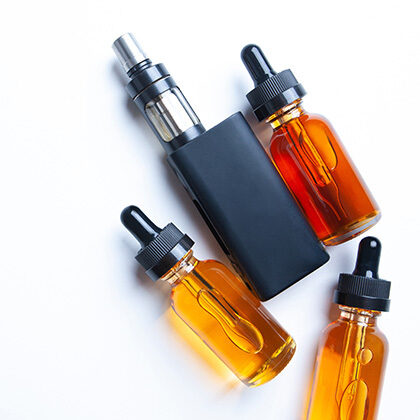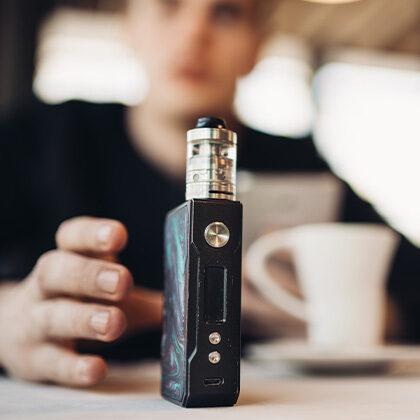

The Dangers of Vaping
Recently, vaping has become a popular hobby amongst adults and teenagers. It's become so common that doctors are starting to face the effects in the emergency room. Vaping is no longer a safe alternative to tobacco smoking and the evidence should not be ignored.
The Schneck Pulmonology team has extensive experience treating respiratory illnesses. Please contact us for an appointment if your lungs have been affected due to vaping or smoking.


What Is a Vape?
E-cigarettes, or “vapes”, are electronic devices that mimic a cigarette. They produce a "vapor" that contains nicotine and other harmful chemicals. Vapes are used as a tool by people who want to quit cigarettes because they contain fewer chemicals. Unfortunately, vapes have become a habit for people who don't smoke cigarettes.
Since vapes don’t produce actual smoke like a cigarette, they can be used more often. This means vape users are likely to vape more than people who may have a cigarette habit. More frequent vaping leads to more exposure to the toxic chemicals in vape liquid.
What Is in Vape Liquid?
Some people believe that vapes are much safer than cigarettes. Unfortunately, this is not completely true. It's one of many myths about vaping that misinform users.
Vaping isn't as harmful to your lungs as a cigarette because you inhale fewer chemicals. But, the chemicals found in vape liquid can still cause serious damage to your body.
Remember, a vape does not produce smoke like a cigarette because it is not burning tobacco. This is why the chemicals in vape liquid are needed.
Every brand of vape has different ingredients. These ingredients are different because each brand uses its own mixture of chemicals. Below are a few common chemicals found in most vapes.
Nicotine is extracted from tobacco plants. Vape liquid uses freebase nicotine which is obtained from tobacco plants using chemicals like ammonia(1). Nicotine is an addictive chemical that makes it difficult for people to quit using vapes.
Propylene Glycol (PG) & Glycerin are syrup-like substances that help retain moisture. They are used to deliver the flavoring and nicotine in vape liquid and are also found in some food, antifreeze, paint solvent, and fog machines.
Carcinogens such as formaldehyde and acetaldehyde have been identified in vape liquid and are known to cause cancer.
Diacetyl is a chemical that is used to add flavor. It has been linked to diseases of the lung(2).
Vaping Side Effects
Vapes have not been used long enough for doctors to understand the long-term health effects. But, despite the lack of research, several cases of lung damage due to vaping have been reported.
The toxic metals in vape liquid are to blame for most of the illnesses. The amount of nicotine in the vape liquid causes the addiction that leads to lung damage.
It's a cycle that repeats itself until the user experiences life-threatening issues.
Consider the following examples of dangerous vaping side effects:
Nicotine is inhaled by vape users more often than cigarette users. This causes a serious addiction and leads to side effects.
If a user doesn't vape for a while, they might experience nicotine withdrawal. A person experiencing withdrawal may be irritable or angry. They might suffer from insomnia, anxiety, or depression(3). Though these symptoms do go away over time, they make daily life difficult until they subside.
Other side effects of nicotine include damage to the brain and internal organs. In some studies, nicotine has been proven to lead to cancer(4).
The first long-term study conducted on vaping found that consistent vape users developed life-threatening lung problems. The study focused on a group of 32,000 adults in the US over the span of 3 years.
It was determined that the adults participating in the study who vaped were 30% more likely to develop a lung problem such as asthma, bronchitis, or emphysema(5).
A woman in her late 40s, who consistently used a vape for 6 months, developed a type of pneumonia typically contracted by people who work with hard metals. The woman was experiencing shortness of breath, a non-productive cough, and wheezing.
Doctors evaluated her lung tissue and determined she had “cobalt lung”, a lung disease she should not have been experiencing because she wasn’t exposed to hard metals in her daily work and life environment.
Upon testing the liquid in her vape, doctors were able to draw a direct connection between her vape use and the lung disease that scarred her lungs(6).
In what could be considered the worst example of a vaping side effect, a teenager had to receive a double lung transplant as a result of his vaping habit.
The teenager was experiencing pneumonia-like symptoms when his lungs started to deteriorate rapidly. He eventually needed a lung transplant due to complete lung failure.
Details about the incident were kept private by the doctors involved, but a direct correlation to the teens vaping habits was admitted(7).

How to Quit Vaping
It's clear that vaping can be a negative habit in your life. But, just knowing this doesn't make quitting vaping any easier. Being in the right mindset before you start can help you overcome the difficulty, though. If you're serious about quitting, consider the following tips:
- Inform Your Friends and Family - Start by telling the people close to you that you plan on leading a healthier, smoke-free life. They will help you commit to your plan and keep you accountable when you get cravings.
- Remove Temptation - Give yourself the highest chance for success by removing temptations. Throw out your vapes and vaping materials. Clear your living spaces of anything that may keep you from quitting. It may be difficult to stop if you keep these things around.
- Think About the Positives - Keep in mind how much healthier your life will be once you've completely given up vaping. Focusing on these positive aspects will help you stay committed to this important life change.
With the right mindset and some preparation, you can commit to quitting this dangerous habit. For more helpful tips, check out our quitting smoking blog.
Free resources are available to anyone who would like to quit smoking cigarettes and using vapes.
Call 1-800-QUIT-NOW to speak with a quitting coach.
Schneck Can Help
Schneck's Pulmology team has the expertise to support you on your journey. Consider scheduling an appointment to get a lung screening so our doctors can determine if you're at risk of any lung issues and provide some help with quitting.
